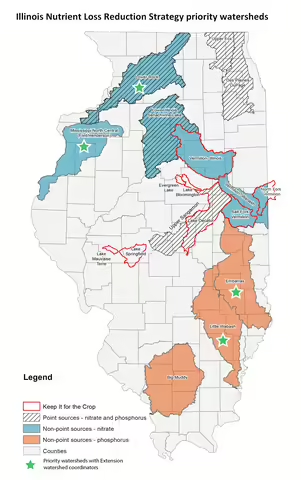Watershed-based planning groups assess conditions and develop action plans.
Developing a watershed plan is an impactful way to address nutrient losses on a watershed scale. A watershed-based plan is a document that provides an assessment of current conditions and identifies issues that impair local water quality. It also identifies and prioritizes solutions and incentives that can lead to improved and protected water quality in the watershed. By integrating recommended management and conservation practices for agriculture, point sources, and urban stormwater sectors, the plan creates a comprehensive framework for the restoration and protection of local waters and those downstream.
The watershed-based planning process and execution relies on the voluntary participation and effort of multiple stakeholders. With financial support, consultants are engaged, and development occurs in partnership with local government entities, businesses, nonprofits, and residents. To strengthen the planning and its outcomes, it is essential for watershed-based planners to be aware of priority watersheds. A successful plan outlines a clear schedule for implementing management measures, sets interim, measurable milestones for timely execution, benchmarks for progress towards water quality goals and load reduction targets, and incorporates a monitoring component to evaluate success.
The watershed-based planning stakeholders, which include community members, local government agencies, farmers, and landowners, unite to secure grant funding to implement the plan, such as from the Illinois EPA 319 program or 604(b) program. By following the plan and monitoring developments, stakeholders can ensure progress toward a healthier watershed.
Use the Resource Management Mapping Service
A watershed plan is the foundation to securing state and federal cost-share dollars.
To qualify for such financial support, each watershed-based plan must cover 50 criteria specified by the Illinois EPA. The plan must be approved to receive financial awards to support the implementation of the plan. The grant also requires the creation of an education plan, which can be developed with the help of an Illinois Extension watershed outreach associate. In addition, a range of Extension partners contribute to further support and resources for watershed-based planning.
Through stakeholder collaboration, watershed-based plans can identify local nutrient loss issues from point and non-point sources, and can plan for implementation of nutrient loss reduction practices, technical support and funding. Illinois Extension staff can assist with educating watershed groups on various nutrient reduction solutions to include in their plans.
How Illinois Extension helps
Staff from Illinois Extension collaborate with local, state, and federal agencies to bolster watershed-based planning in Illinois' priority watersheds. This team offers:
- Assistance coordinating watershed assessments.
- Training, education, and networking to share:
- Watershed information
- Watershed-based planning processes and tools, including Illinois EPA and U.S. EPA resources
- Conservation practices information
- Cost-share incentive programs information
- Grant writing support
- Facilitation of The Watershed Game to engage with stakeholders
Part 1: Water Quality/Watershed Financial Assistance Programs 101 – The Big Picture
This webinar will provide an overview of Illinois EPA’s financial assistance programs available for water quality and watershed protection throughout Illinois. The session will present information on...
This informational series covers the following programs:
- Session 1: Water Quality/Watershed Financial Assistance Programs 101 – The Big Picture (Recording: February 10, 2022)
- Session 2: Nonpoint Source Pollution Control (Section 319) Grant FUNDING with a...
Explore how watershed-based planning is a collaborative, stakeholder-supported approach to improving and protecting water resources. Learn how Illinois conservation professionals are working with local stakeholders to preserve our natural resources.

Rachel Curry

Nicole Haverback

Joan Cox

Amanda Christenson

